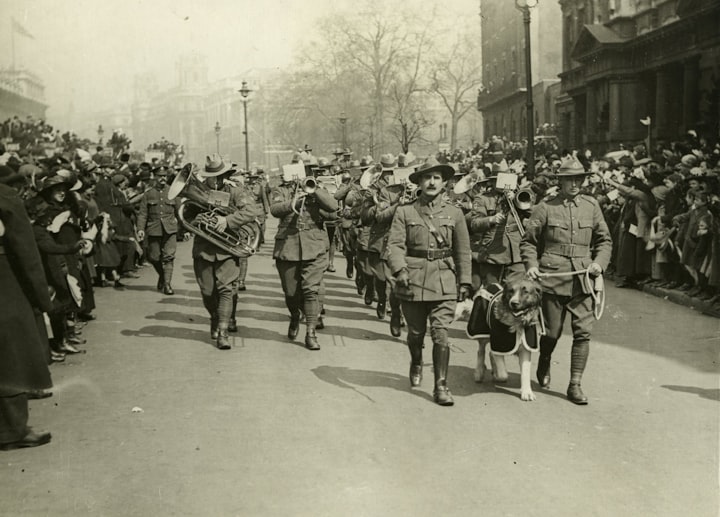
World War II stands as the largest armed conflict in human history—a deadly global war involving tens of millions of combatants. Let's chart the course of this monumental conflict on the world map while summarizing its key events.
Following World War I, Germany and its allies found themselves defeated and squarely blamed for the conflict. Punitive measures, including heavy sanctions, led to the dismantling of the Austro-Hungarian and Ottoman empires. Germany was burdened with an onerous debt and saw some of its colonies and territories ceded to the victors, while Poland was reborn. These sanctions deeply wounded the pride of the German people.
Germany's economy suffered under the weight of excessive debt and spiraled into hyperinflation. To combat this, national mints resorted to printing vast quantities of banknotes, leading to a catastrophic devaluation of the currency. Between 1914 and November 1923, the value of the German mark plummeted by an astonishing 1,000 billion times.
In the subsequent year, radical measures were enacted to curb inflation, stabilize the economy, and facilitate recovery. However, in 1929, the Wall Street Crash in New York triggered the worst economic crisis of the 20th century, reverberating globally, including in Germany, where unemployment soared.
By 1933, Germany witnessed the ascent of nationalism, paving the way for the Nazi Party under Adolf Hitler's leadership. Despite the stringent conditions imposed after WWI, the new totalitarian regime overhauled the nation, reintroducing military service and pursuing an assertive foreign policy aimed at uniting all German-speaking people.
In Italy, frustration brewed over the territorial gains following WWI. Since 1922, Benito Mussolini's dictatorial fascist party held sway. Italy embarked on a colonial venture, annexing Ethiopia and preparing an invasion of Albania.
Meanwhile, Spain was engulfed in a three-year civil war, with the Republican government receiving support from the USSR and the International Brigades, while nationalists, led by Francisco Franco and aided by Italy and Germany, formed the opposing camp. This conflict served as a testing ground for both countries' armies and brought them closer diplomatically.
In Asia, Japan continued its expansionist policies, capitalizing on the chaos of the Chinese Civil War to seize new territories, employing chemical and biological weapons and committing mass atrocities.
Germany's growing power led to territorial expansion, starting with the annexation of Austria, supported by the local Nazi party. Next, they targeted western Czechoslovakia. The Slovak Republic became a German satellite state, and diplomatic ties with Hungary deepened.
After occupying part of Lithuania, Germany signed a non-aggression pact with the USSR and a plan to carve up Europe. This pact was followed by the invasion of Poland, prompting the United Kingdom and France to declare war, marking the onset of World War II.
While German forces concentrated in the East, the Allies initially refrained from launching an offensive in the West. Instead, France and the United Kingdom attempted to sever the strategic iron ore supply route passing through Norway, crucial for the German military. Germany's response was the invasion of Denmark and Norway, swiftly capturing Luxembourg, the Netherlands, and Belgium.
Hitler's innovative military strategy, known as Blitzkrieg, caught opposition defenses off-guard with rapid, high-intensity attacks focused on specific areas. British forces retreated, and the German army advanced on Paris. The French army's defeat led to an armistice, with Germany occupying northern and western France. Other French territories and colonies came under the control of the new government, allowing Germany indirect control of French colonies without the need for military presence. However, some French colonies and the Belgian Congo chose to remain aligned with the Allies.
In London, a hub for governments in exile, General Charles de Gaulle established Free France, continuing the fight against Nazi Germany, with Brazzaville as its capital.
Pursuant to agreements with Germany, the Soviet Union seized the Baltic states and parts of Romania. This alliance between Germany, Italy, and Japan formed the Axis Powers. All British dominions and colonies (except Ireland) entered the war. Fighting erupted between Italian colonies and Allied forces in Africa, while in Europe, despite massive aerial bombings of British cities, Germany failed to conquer the UK.
Hitler shifted his focus towards invading the USSR, but this plan was delayed by Italy's unsuccessful invasion of Greece, met with resistance from the Allies. Following Hungary, Romania, and Bulgaria's alignment with the Axis, German forces headed south, invading Yugoslavia and Greece.
Resistance movements emerged throughout Europe in various forms, from strikes and demonstrations to sheltering wanted individuals. Some groups spied for the Allies, conducted sabotage, or printed resistance newspapers. In Eastern Europe, guerrilla forces harassed the Axis armies, while Yugoslavia and Greece witnessed clashes between resistant communists and royalist groups.
Even within Germany, anti-Nazi sentiment led to several unsuccessful attempts to assassinate Hitler.
On June 22, Axis forces launched one of the largest military operations in history against the USSR, which effectively joined the Allied camp. Well-equipped and motorized, the bulk of German troops surged eastward, while Allies occupied Iran, establishing a supply route through the Caucasus.
German forces besieged Leningrad, resulting in a 872-day ordeal that claimed over a million civilian lives. Further south, German troops encountered fierce resistance at the gates of Moscow and suffered through a brutal winter. Behind enemy lines, the SS committed atrocities against Slavic and Jewish populations while in Asia, Japan occupied French Indochina.
In response to Japan's expansionist policies, the United States imposed an embargo on oil and steel. In retaliation, Japan conducted a surprise attack on Pearl Harbor, causing significant damage to the US naval fleet. Subsequently, the United States entered the war on the side of the Allies, initially focusing their efforts on the Pacific front. They also provided essential supplies to the USSR, which continued its resistance against the advancing German forces.
Japan continued to expand in the Pacific, accompanied by horrifying actions such as sending 10 million Chinese civilians into forced labor camps. In Indonesia, millions of prisoners suffered the same fate on the island of Java. Allied prisoners faced grueling conditions while constructing a railway line in Burma and Thailand. Additionally, hundreds of thousands of women were forcibly recruited into prostitution for the Japanese army.
In Europe, concentration and extermination camps were established to target various groups, including Jews, resistance fighters, political opponents, gypsies, homosexuals, and people with disabilities. Fearing a potential second front in Europe, Hitler constructed the Atlantic Wall, a series of military installations meant to protect the coast from invasion. However, the Allies initially landed in Morocco and Algeria, putting Italian Libya in a precarious position. Vichy France, having lost control of its colonies, was invaded.
In the East, Axis forces attempted to sever the supply route to the Caucasus, but for the first time, the German offensive faced a significant military setback. The Soviets took the initiative and launched a counterattack. Africa came under full Allied control, culminating in a landing in Sicily. The new Italian government sought an armistice, leading to a German invasion. The USSR rapidly advanced westward, compelling the German army to shift its focus to that front.
On June 6, 1944, the Allies landed in Normandy, swiftly liberating Paris. Countries in both the East and West either switched allegiances or were liberated. As victory seemed imminent, the Allied powers announced the formation of the United Nations. Countries that had declared war on Germany and Japan were invited to join at the founding conference. This led to a wave of declarations of war, albeit without significant consequences.
On April 30, Hitler committed suicide in his bunker just before the arrival of the Soviets. Eight days later, Germany surrendered. The United States and the USSR united their efforts to defeat the Empire of Japan. The Soviets launched a military invasion via Manchuria, while the United States dropped two atomic bombs on Hiroshima and Nagasaki. On August 15, Japan surrendered, marking the end of World War II.
After six years of conflict, the human toll was staggering, with at least 60 million casualties, primarily civilians. Numerous cities lay in ruins. Europe and the USSR subjected millions of German prisoners of war to forced labor, resulting in many deaths. Germany and Austria were divided among the victors, leaving the old European powers exhausted and devastated by the war. The United States and the USSR emerged as the world's dominant superpowers. Despite the United Nations' mission to maintain global peace and security, both sides eventually engaged in indirect confrontations worldwide."





Comments (1)
Fascinating history!